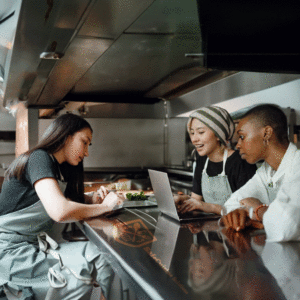
Creating a strong foundation of food safety knowledge and skills among your staff is essential for maintaining a safe and hygienic environment in your restaurant. An effective food safety training program not only ensures compliance with regulations but also instills a culture of responsibility and commitment to the well-being of your customers. In this blog post, we will provide guidance on developing an effective food safety training program that empowers your staff to uphold the highest standards of food safety.
Key Steps to Develop an Effective Food Safety Training Program:
- Assess Your Training Needs: Begin by assessing your restaurant’s specific training needs. Consider local health department regulations, industry best practices, and potential risks associated with your operations. Identify areas where additional training is necessary, such as proper food handling, cross-contamination prevention, personal hygiene, temperature control, allergen management, and cleaning procedures.
- Define Training Objectives: Clearly define the objectives of your food safety training program. Align these objectives with your restaurant’s needs and goals. For example, objectives may include ensuring staff understand and follow proper food handling practices, recognizing potential hazards, implementing correct sanitation procedures, and understanding their role in maintaining food safety.
- Develop Comprehensive Training Materials: Create well-structured and comprehensive training materials that cover all relevant food safety topics identified in the training needs assessment. These materials can include written manuals, visual aids, presentations, videos, and interactive modules. Ensure the materials are easily accessible, engaging, and tailored to your restaurant’s operations.
- Implement Interactive Learning Strategies: Foster active participation and engagement among your staff by incorporating interactive learning strategies. This can include hands-on demonstrations, group discussions, case studies, and quizzes. Interactive learning encourages staff to apply their knowledge in practical situations and promotes a deeper understanding of food safety principles.
- Provide Regular Training Sessions: Establish a regular schedule for food safety training sessions. Conduct initial training for new hires and ongoing training for existing staff. Reinforce the importance of food safety during pre-shift meetings and incorporate refresher courses to keep staff updated on best practices and regulatory changes.
- Emphasize Practical Application: Bridge the gap between training and real-world application by providing opportunities for staff to apply their knowledge in the workplace. Encourage them to practice proper food handling techniques, utilize appropriate cleaning procedures, and follow safe food storage practices. Provide feedback and reinforcement to ensure consistent adherence to food safety protocols.
- Encourage Accountability and Continuous Improvement: Foster a culture of accountability by empowering staff to take ownership of food safety practices. Encourage them to report potential hazards, suggest improvements, and participate in regular self-assessments or internal audits. Recognize and reward staff who consistently demonstrate exemplary food safety practices.
Developing an effective food safety training program is essential for creating a safe and hygienic environment in your restaurant. By assessing training needs, defining clear objectives, providing comprehensive materials, implementing interactive learning strategies, and emphasizing practical application, you can empower your staff to prioritize food safety. Remember to encourage accountability and promote a culture of continuous improvement. Together, let’s build a team that is knowledgeable, responsible, and committed to upholding the highest standards of food safety.
At SafeCuisine Solutions, we offer customized food safety training programs tailored to your restaurant’s unique needs. Contact us today to enhance your staff’s food safety knowledge and create a safer dining experience for your customers.

